英语综合实践课
英语综合实践活动课教案
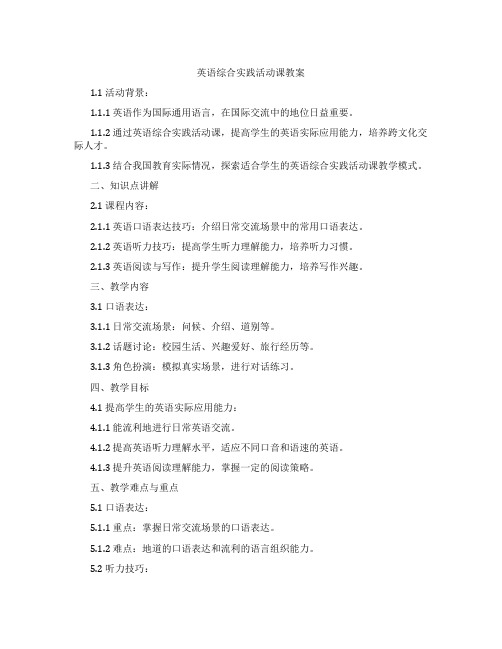
英语综合实践活动课教案1.1 活动背景:1.1.1 英语作为国际通用语言,在国际交流中的地位日益重要。
1.1.2 通过英语综合实践活动课,提高学生的英语实际应用能力,培养跨文化交际人才。
1.1.3 结合我国教育实际情况,探索适合学生的英语综合实践活动课教学模式。
二、知识点讲解2.1 课程内容:2.1.1 英语口语表达技巧:介绍日常交流场景中的常用口语表达。
2.1.2 英语听力技巧:提高学生听力理解能力,培养听力习惯。
2.1.3 英语阅读与写作:提升学生阅读理解能力,培养写作兴趣。
三、教学内容3.1 口语表达:3.1.1 日常交流场景:问候、介绍、道别等。
3.1.2 话题讨论:校园生活、兴趣爱好、旅行经历等。
3.1.3 角色扮演:模拟真实场景,进行对话练习。
四、教学目标4.1 提高学生的英语实际应用能力:4.1.1 能流利地进行日常英语交流。
4.1.2 提高英语听力理解水平,适应不同口音和语速的英语。
4.1.3 提升英语阅读理解能力,掌握一定的阅读策略。
五、教学难点与重点5.1 口语表达:5.1.1 重点:掌握日常交流场景的口语表达。
5.1.2 难点:地道的口语表达和流利的语言组织能力。
5.2 听力技巧:5.2.1 重点:提高听力理解能力。
5.2.2 难点:适应不同口音和语速的英语听力。
5.3 阅读与写作:5.3.1 重点:提升阅读理解能力。
5.3.2 难点:运用阅读策略和提高写作水平。
六、教具与学具准备6.1 教具:6.1.1 教学PPT:包含课程内容、听力材料、阅读材料等。
6.1.2 实物道具:如图片、卡片等,用于情景模拟和角色扮演。
6.1.3 音响设备:用于播放听力材料。
6.2 学具:6.2.1 笔记本:用于记录重点知识和练习。
6.2.2 练习册:用于巩固所学知识和技能。
6.2.3 词汇卡片:用于学习和复习词汇。
七、教学过程7.1 导入:7.1.1 热身活动:简单的英语口语练习,如问候、自我介绍等。
初中英语综合实践说课稿
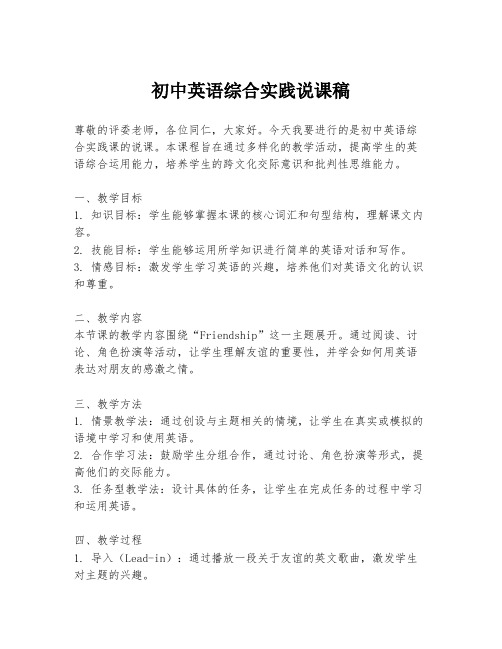
初中英语综合实践说课稿尊敬的评委老师,各位同仁,大家好。
今天我要进行的是初中英语综合实践课的说课。
本课程旨在通过多样化的教学活动,提高学生的英语综合运用能力,培养学生的跨文化交际意识和批判性思维能力。
一、教学目标1. 知识目标:学生能够掌握本课的核心词汇和句型结构,理解课文内容。
2. 技能目标:学生能够运用所学知识进行简单的英语对话和写作。
3. 情感目标:激发学生学习英语的兴趣,培养他们对英语文化的认识和尊重。
二、教学内容本节课的教学内容围绕“Friendship”这一主题展开。
通过阅读、讨论、角色扮演等活动,让学生理解友谊的重要性,并学会如何用英语表达对朋友的感激之情。
三、教学方法1. 情景教学法:通过创设与主题相关的情境,让学生在真实或模拟的语境中学习和使用英语。
2. 合作学习法:鼓励学生分组合作,通过讨论、角色扮演等形式,提高他们的交际能力。
3. 任务型教学法:设计具体的任务,让学生在完成任务的过程中学习和运用英语。
四、教学过程1. 导入(Lead-in):通过播放一段关于友谊的英文歌曲,激发学生对主题的兴趣。
2. 呈现(Presentation):展示与友谊相关的图片和词汇,引导学生学习新词汇和句型。
3. 练习(Practice):通过小组讨论,让学生运用所学词汇和句型描述自己的友谊故事。
4. 应用(Application):设计角色扮演活动,让学生模拟不同场景下的友谊对话。
5. 产出(Production):让学生写一篇短文,表达对朋友的感激之情,并在班级前进行分享。
五、教学评价1. 过程评价:观察学生在课堂活动中的参与度和合作情况。
2. 结果评价:通过学生的短文写作和口头表达,评价他们对本课内容的掌握程度。
六、教学反思课后,我会反思教学过程中的不足之处,如学生参与度、活动设计的有效性等,并根据学生的反馈进行调整,以提高教学效果。
通过本节课的教学,我希望能够引导学生深入理解友谊的内涵,同时提高他们用英语进行交流的能力。
大学生英语综合实践教案

课程目标:1. 提高学生的英语听说读写综合能力。
2. 培养学生的团队合作精神和跨文化交流能力。
3. 增强学生对英语学习的兴趣和自信心。
课程内容:一、教学时间:4课时二、教学对象:大学生三、教学资源:多媒体课件、英语教材、英语歌曲、英语电影片段、小组活动道具等。
四、教学过程:第一课时:1. 导入- 教师简要介绍本次课程的目的和内容。
- 学生自由发言,分享自己感兴趣的英语学习话题。
2. 听力训练- 教师播放一段英语听力材料,让学生听后回答问题。
- 学生分组讨论,分享自己的答案和听力技巧。
3. 词汇学习- 教师讲解一些常用的英语词汇,并进行例句展示。
- 学生跟随教师一起朗读和拼写新词汇。
4. 小组活动- 学生分组,每组选取一个主题进行英语对话练习。
- 教师巡回指导,帮助学生纠正发音和语法错误。
第二课时:1. 口语练习- 学生分组,每组选择一个场景进行角色扮演,模拟真实生活中的英语对话。
- 教师点评并给出改进建议。
2. 阅读理解- 教师发放一篇英语阅读材料,让学生阅读并回答问题。
- 学生分组讨论,分享自己的理解和观点。
3. 写作训练- 教师讲解英语写作的基本结构和技巧。
- 学生根据所学内容,完成一篇简短的英语作文。
4. 小组活动- 学生分组,每组根据所学内容,创作一个英语小剧本。
- 教师指导学生进行排练,并邀请其他小组观看。
第三课时:1. 视听结合- 教师播放一段英语电影片段或歌曲,让学生观看并模仿发音和语调。
- 学生分组,每组选择一段喜欢的英语歌曲,进行演唱和表演。
2. 文化交流- 学生分组,每组介绍一个国家的文化特点,用英语进行演讲。
- 教师点评并给出建议。
3. 小组活动- 学生分组,每组根据所学内容,设计一个英语游戏或活动,进行展示和分享。
第四课时:1. 总结与反思- 教师总结本次课程的重点内容,并引导学生进行反思。
- 学生分享自己在课程中的收获和体会。
2. 课后作业- 教师布置课后作业,要求学生完成一篇英语日记或撰写一篇英语小论文。
英语综合实践课教学方法(3篇)
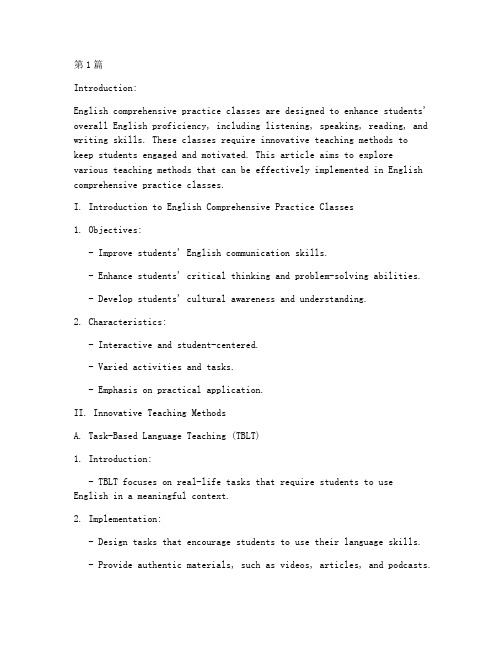
第1篇Introduction:English comprehensive practice classes are designed to enhance students' overall English proficiency, including listening, speaking, reading, and writing skills. These classes require innovative teaching methods to keep students engaged and motivated. This article aims to explore various teaching methods that can be effectively implemented in English comprehensive practice classes.I. Introduction to English Comprehensive Practice Classes1. Objectives:- Improve students' English communication skills.- Enhance students' critical thinking and problem-solving abilities.- Develop students' cultural awareness and understanding.2. Characteristics:- Interactive and student-centered.- Varied activities and tasks.- Emphasis on practical application.II. Innovative Teaching MethodsA. Task-Based Language Teaching (TBLT)1. Introduction:- TBLT focuses on real-life tasks that require students to use English in a meaningful context.2. Implementation:- Design tasks that encourage students to use their language skills.- Provide authentic materials, such as videos, articles, and podcasts.- Assign roles and responsibilities to students, fostering teamwork and collaboration.B. Project-Based Learning (PBL)1. Introduction:- PBL involves students in an extended inquiry process to complete a complex project.2. Implementation:- Select a theme or topic relevant to the students' interests and needs.- Break down the project into manageable tasks with clear objectives.- Encourage students to research, plan, and present their findings.C. Cooperative Learning1. Introduction:- Cooperative learning involves students working in groups to achieve a common goal.2. Implementation:- Form heterogeneous groups to ensure diverse perspectives and skills.- Assign roles within the group, such as leader, note-taker, andtime-keeper.- Provide clear guidelines and objectives for group work.D. Flipped Classroom1. Introduction:- The flipped classroom model reverses traditional teaching, where students learn new content outside the classroom and engage in hands-on activities during class time.2. Implementation:- Provide online resources or videos for students to watch or read at home.- Design class activities that reinforce the learning, such as discussions, problem-solving, or practical exercises.E. Gamification1. Introduction:- Gamification involves incorporating game-like elements into the learning process to increase engagement and motivation.2. Implementation:- Create point systems or badges for students who complete tasks or achieve certain milestones.- Use educational apps or platforms that offer gamified learning experiences.F. Technology Integration1. Introduction:- Integrating technology into the classroom can enhance learning experiences and provide access to a wide range of resources.2. Implementation:- Utilize educational software, such as language learning platforms or interactive whiteboards.- Incorporate multimedia resources, such as videos, podcasts, and online articles.III. Assessment and Feedback1. Formative Assessment:- Regularly assess students' progress through quizzes, oral presentations, and group projects.- Provide constructive feedback to help students improve their language skills.2. Summative Assessment:- Administer final exams or assessments to evaluate students' overall proficiency.Conclusion:Innovative teaching methods are crucial for English comprehensive practice classes to ensure students develop their language skills effectively. By incorporating TBLT, PBL, cooperative learning, flipped classrooms, gamification, and technology integration, teachers can create engaging and interactive learning environments. Regular assessment and feedback are also essential to monitor students' progress and provide support when needed. By adopting these methods, English comprehensive practice classes can become more effective and enjoyable for both students and teachers.第2篇Abstract:This paper proposes innovative teaching methods for comprehensive English practice courses. It emphasizes the integration of technology, collaborative learning, and project-based approaches to enhancestudents' language proficiency, critical thinking, and communication skills. The paper outlines the methods, discusses their implementation, and evaluates their effectiveness in improving student learning outcomes.I. IntroductionComprehensive English practice courses are designed to provide students with an integrated approach to learning English, focusing on speaking, listening, reading, and writing skills. However, traditional teaching methods often lack engagement and fail to cater to individual learning styles. This paper presents innovative teaching methods that aim to address these challenges and enhance the learning experience for students.II. Integrating Technology1. Use of Learning Management Systems (LMS)LMS platforms such as Moodle and Blackboard can be utilized to create an online learning environment where students can access course materials, submit assignments, and participate in discussions. This facilitates flexibility and self-paced learning.2. Incorporation of Multimedia ResourcesMultimedia resources like videos, podcasts, and interactive quizzes can be used to engage students in different learning modalities. These resources can be integrated into lesson plans to cater to visual, auditory, and kinesthetic learners.3. Virtual Reality (VR) and Augmented Reality (AR)VR and AR technologies can provide immersive learning experiences, allowing students to practice English in simulated real-life scenarios. For example, VR can be used to simulate conversations in foreign countries, while AR can overlay English translations on physical objects.III. Collaborative Learning1. Group ProjectsGroup projects encourage students to work together, fostering teamwork and communication skills. Students can collaborate on tasks such asrole-playing, debates, and presentations, which require them to use English in various contexts.2. Peer TeachingPeer teaching involves students teaching each other, which can improve their language proficiency and confidence. For example, students canpair up to practice dialogues or present lessons on grammar topics.3. Online Discussion ForumsDiscussion forums on LMS platforms enable students to share their thoughts, ask questions, and engage in meaningful conversations. This encourages active participation and critical thinking.IV. Project-Based Learning1. Real-World ProjectsProject-based learning (PBL) involves students in completing tasks that are relevant to real-world scenarios. For example, students can create a travel guide in English, write a business report, or design a marketing campaign.2. Inquiry-Based LearningInquiry-based learning (IBL) encourages students to ask questions, investigate, and find answers related to the subject matter. This approach can be applied to various topics in English, such as cultural studies or environmental issues.3. Reflection and EvaluationStudents should be encouraged to reflect on their learning experiences and evaluate their progress. This can be done through self-assessment, peer assessment, and teacher feedback.V. Implementation and Evaluation1. Training TeachersTeachers should be trained to use the proposed methods effectively. This can be achieved through workshops, webinars, and collaboration with educational technology experts.2. Monitoring Student ProgressRegular assessments, quizzes, and projects should be used to monitor student progress. Data collected can be analyzed to identify areas of improvement and adjust teaching strategies accordingly.3. Feedback and AdaptationFeedback from students and colleagues should be used to refine the teaching methods. Continuous adaptation is essential to ensure the effectiveness of the approach.VI. ConclusionInnovative teaching methods for comprehensive English practice courses can significantly enhance students' language proficiency and critical thinking skills. By integrating technology, fostering collaborative learning, and implementing project-based approaches, teachers can create a dynamic and engaging learning environment. Continuous evaluation and adaptation of teaching strategies are essential to ensure the success of these methods in improving student learning outcomes.第3篇Introduction:In the context of globalized education, the importance of English language proficiency cannot be overstated. Integrated English practice classes play a crucial role in enhancing students' language skills, including speaking, listening, reading, and writing. However,traditional teaching methods often fail to engage students and promote active learning. This article aims to explore innovative teaching methods that can be effectively implemented in integrated English practice classes to foster a more dynamic and interactive learning environment.1. Project-Based Learning (PBL)Project-Based Learning is an effective method that encourages students to work collaboratively on real-world projects. By incorporating PBLinto integrated English practice classes, students can apply their language skills in practical situations. Here are some steps to implement PBL:a. Identify a relevant project topic that aligns with the course objectives.b. Divide students into small groups, ensuring diverse skill levels.c. Provide students with guidelines and resources to complete the project.d. Assign specific roles and responsibilities to each group member.e. Monitor the progress of the project and offer guidance when needed.f. Present the final project to the class and encourage peer evaluation.2. Flipped ClassroomThe flipped classroom model reverses the traditional teaching approach by shifting the focus from teacher-led lectures to student-led activities. This method can be particularly beneficial in integrated English practice classes. Here's how to implement the flipped classroom:a. Record short video lectures covering the essential language points.b. Assign viewing tasks for students to complete before class.c. Design interactive class activities that reinforce the concepts learned in the videos.d. Encourage students to ask questions and engage in discussions.e. Provide opportunities for students to practice their language skills through role-playing, debates, or group presentations.3. GamificationGamification involves incorporating game elements into the learning process, which can make integrated English practice classes more engaging and enjoyable. Here are some gamification strategies:a. Create a point system for completing tasks, such as reading assignments, quizzes, or class participation.b. Organize group challenges and reward the winning team with points or small prizes.c. Implement a leaderboard to motivate students to compete with their peers.d. Use educational apps or platforms that offer gamified language learning experiences.e. Design game-based activities, such as treasure hunts or word searches, to reinforce language concepts.4. Collaborative LearningCollaborative learning encourages students to work together in groups to achieve a common goal. This approach can enhance communication skillsand promote a supportive learning environment. Here's how to implement collaborative learning in integrated English practice classes:a. Assign group projects that require students to research, plan, and present their findings.b. Facilitate group discussions and encourage students to share their ideas and opinions.c. Provide guidelines for effective group collaboration, such as assigning roles and setting clear expectations.d. Organize group activities that require students to communicate and problem-solve together.e. Assess group projects based on both individual and collective contributions.5. Technology IntegrationLeveraging technology can make integrated English practice classes more dynamic and accessible. Here are some technology integration strategies:a. Use educational platforms, such as Google Classroom or Edmodo, to share resources, assignments, and feedback.b. Incorporate multimedia elements, such as videos, podcasts, and interactive quizzes, into lesson plans.c. Utilize language learning apps and online resources to supplement traditional teaching methods.d. Implement virtual reality (VR) or augmented reality (AR) to create immersive language learning experiences.e. Encourage students to use social media platforms, such as Twitter or Instagram, to practice writing and communication skills.Conclusion:Innovative teaching methods can transform integrated English practice classes into engaging and effective learning environments. By incorporating Project-Based Learning, the flipped classroom, gamification, collaborative learning, and technology integration, educators can foster a dynamic and interactive learning experience that promotes active participation and language proficiency. Embracing these methods can lead to improved student engagement, achievement, and overall language skills.。
英语综合实践课教学设计(3篇)
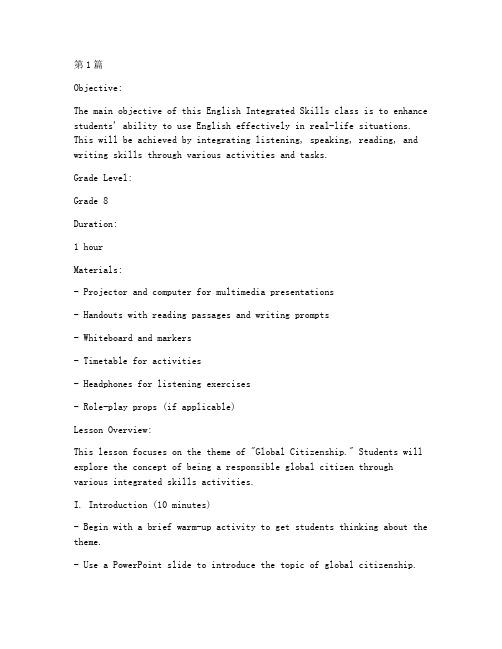
第1篇Objective:The main objective of this English Integrated Skills class is to enhance students' ability to use English effectively in real-life situations. This will be achieved by integrating listening, speaking, reading, and writing skills through various activities and tasks.Grade Level:Grade 8Duration:1 hourMaterials:- Projector and computer for multimedia presentations- Handouts with reading passages and writing prompts- Whiteboard and markers- Timetable for activities- Headphones for listening exercises- Role-play props (if applicable)Lesson Overview:This lesson focuses on the theme of "Global Citizenship." Students will explore the concept of being a responsible global citizen through various integrated skills activities.I. Introduction (10 minutes)- Begin with a brief warm-up activity to get students thinking about the theme.- Use a PowerPoint slide to introduce the topic of global citizenship.- Ask students to share their initial thoughts and ideas about what it means to be a global citizen.II. Listening and Note-Taking (15 minutes)- Play a short audio clip related to global citizenship (e.g., a TEDTalk or a news report).- Instruct students to listen actively and take notes on key points.- Pause the audio at intervals and ask students to share their notes and discuss the information they have gathered.III. Reading and Discussion (20 minutes)- Distribute a handout with a reading passage on global citizenship.- Encourage students to read the passage silently and then discuss it in pairs or small groups.- Ask questions to guide the discussion, such as:- What are the main challenges faced by global citizens?- How can individuals contribute to global issues?- What are some positive examples of global citizenship?IV. Speaking and Role-Play (15 minutes)- Divide the class into groups of three or four.- Assign each group a scenario related to global citizenship (e.g., environmental conservation, cultural exchange, or social justice).- Instruct students to prepare a short role-play based on their scenario, using the information from the listening and reading activities.- Have each group present their role-play to the class, and thenfacilitate a discussion about the scenarios.V. Writing and Reflection (20 minutes)- Provide students with a writing prompt related to global citizenship (e.g., "How can you be a more responsible global citizen in your daily life?").- Instruct students to write a short essay or journal entry in response to the prompt.- Encourage students to reflect on their own experiences and ideas, and to use evidence from the lesson to support their arguments.VI. Conclusion and Assessment (10 minutes)- Summarize the key points of the lesson and reinforce the importance of global citizenship.- Conduct a quick assessment of the students' understanding by asking them to share one thing they learned or one action they plan to take as a result of the lesson.- Provide feedback on the students' writing and encourage them to continue exploring the theme of global citizenship in their own time.Assessment Criteria:- Active participation in all activities- Accuracy and fluency in speaking and listening- Clarity and coherence in writing- Depth of understanding and application of the themeExtensions:- Assign a research project on a specific global issue for homework.- Organize a school-wide event or campaign to promote global citizenship.- Invite a guest speaker from a relevant organization to discuss the topic with the class.Evaluation:This lesson will be evaluated based on students' engagement in activities, the quality of their writing, and their ability to demonstrate an understanding of the theme of global citizenship. Formative assessments will be used throughout the lesson to monitor progress and provide feedback. Summative assessments will be conducted at the end of the lesson to evaluate the overall effectiveness of the teaching strategies and activities.第2篇Objective:The objective of this English comprehensive practice class is to enhance students' overall English proficiency through various activities that focus on reading, writing, speaking, and listening skills. The class aims to create an interactive and engaging learning environment that encourages students to apply their language skills in real-life situations.Subject: EnglishGrade Level: 8th GradeDuration: 2 hoursMaterials:- Projector and computer for multimedia presentations- Whiteboard and markers- Handouts with reading materials- Writing materials (pens, pencils, notebooks)- Flashcards for vocabulary practice- English songs or audio clips for listening practice- Role-playing props or costumes (optional)Lesson Overview:This lesson will be divided into four main sections: reading, writing, speaking, and listening. Each section will have specific activities designed to develop the respective skills. The activities will be interactive, allowing students to work individually, in pairs, or in groups.I. Introduction (10 minutes)1. Greet the students and review the objectives of the lesson.2. Briefly explain the structure of the class and what each section will entail.II. Reading (20 minutes)1. Distribute handouts with reading materials relevant to the unit's theme.2. Students will read the material silently for 5 minutes.3. Facilitate a group discussion on the reading material, asking guiding questions to encourage critical thinking.4. Assign a reading comprehension task, such as summarizing the main points or identifying the author's purpose.III. Writing (25 minutes)1. Introduce a writing prompt related to the reading material or a current event.2. Students will write a short essay or paragraph based on the prompt, focusing on proper grammar, punctuation, and vocabulary usage.3. Provide students with a checklist to self-assess their writing.4. Peer-editing session: Students will exchange their writings with a partner and provide constructive feedback.5. Teacher will provide individual feedback on selected essays.IV. Speaking (15 minutes)1. Divide the class into small groups.2. Assign each group a role-play scenario based on the unit's theme.3. Provide students with a list of vocabulary and phrases that may be useful for their role-play.4. Allow each group 5 minutes to practice their role-play.5. Conduct a round of role-plays, with each group presenting their scenario to the class.6. Facilitate a class discussion on the role-plays, encouraging students to analyze the characters' motivations and actions.V. Listening (10 minutes)1. Play an English song or an audio clip related to the unit's theme.2. Students will listen to the audio and answer comprehension questions.3. Discuss the content of the audio and its relevance to the unit's topic.4. Assign a listening comprehension task, such as filling in missing words or identifying the main idea.VI. Conclusion (10 minutes)1. Recap the main points of the lesson, emphasizing the importance of each skill.2. Provide students with a homework assignment that reinforces theskills learned in class.3. Thank the students for their participation and encourage them to continue practicing their English skills outside of the classroom.Assessment:The assessment of this lesson will be based on the following criteria:- Participation and engagement in class activities- Quality of writing and ability to follow the checklist- Performance in role-plays and ability to apply learned vocabulary- Comprehension and understanding of the reading and listening materialsHomework:1. Students will write a short story or journal entry using the vocabulary and themes covered in the lesson.2. Students will listen to an English podcast or watch an English video related to the unit's theme and complete a listening comprehension worksheet.This English comprehensive practice class aims to provide a well-rounded approach to language learning, encouraging students to develop their reading, writing, speaking, and listening skills through interactive and engaging activities.第3篇Objective:The main objective of this English comprehensive practical class is to enhance students' ability to use English in real-life situations, promote their cultural awareness, and foster their critical thinking skills. The class will focus on integrating language learning with practical activities, cultural exploration, and collaborative learning.Duration:Two hoursGrade Level:Grade 7Class Size:30 studentsMaterials Needed:- Projector and computer for presentations- Whiteboard and markers- Handouts (maps, travel brochures, cultural articles)- Interactive online resources (websites, videos, quizzes)- Group work materials (notebooks, pens, scissors, glue)- World mapLesson Overview:1. Introduction (10 minutes)- Welcome and icebreaker activity to get students comfortable with the class environment.- Briefly introduce the topic of the class: Exploring the World Through English.2. Cultural Awareness (15 minutes)- Present a short video clip showcasing different cultures around the world.- Discuss the cultural aspects presented in the video, emphasizing the importance of cultural sensitivity and understanding.3. Language in Use (20 minutes)- Introduce key vocabulary related to travel and cultural exploration (e.g., “adventure,” “sightseeing,” “local cuisine”).- Conduct a role-play activity where students act out a conversation between two tourists and a local guide.- Provide feedback and correct any grammatical errors.4. Interactive Presentation (15 minutes)- Each student selects a country from a world map and presents abrief overview of its culture, history, and famous landmarks.- Use the projector to display relevant images and information.5. Group Activity: Travel Brochure Creation (30 minutes)- Divide the class into groups of three or four.- Each group is given a list of countries and must create a travel brochure for one of the countries.- The brochure should include information about the country’s culture, popular attractions, and tips for tourists.- Students must use the target language (English) to convey their information.6. Collaborative Review (15 minutes)- Each group presents their travel brochure to the class.- The class provides feedback and suggestions for improvement.- The teacher circulates and offers additional support as needed.7. Cultural Exchange (15 minutes)- Students exchange brochures with another group and take turns presenting the information to their peers.- This activity encourages students to engage with the material from different perspectives and deepen their understanding.8. Reflection and Conclusion (10 minutes)- Conduct a brief reflection activity where students write down one thing they learned about another culture and one thing they would like to explore in the future.- Summarize the main points of the class and encourage students to continue exploring the world through English in their daily lives.Assessment:- Participation in class activities and discussions.- Quality and creativity of the travel brochure.- Reflection writing.- Homework assignment: Students will write a short essay on their favorite country from the class and explain why they find it interesting.Additional Notes:- Encourage students to use technology and online resources to research their chosen countries.- Provide opportunities for students to correct each other’s work and learn from each other’s mistakes.- Ensure that the classroom environment is inclusive and respectful of all cultures.- Adjust the difficulty level of the activities according to the students’ proficiency levels.By the end of this comprehensive practical class, students should have a better understanding of different cultures, improved their English language skills, and developed a passion for exploring the world through language.。
大学英语综合实践课收获

在大学四年的学习生涯中,大学英语综合实践课无疑是我收获颇丰的一门课程。
通过这门课程,我不仅提高了英语水平,更在思维、交际、文化等多个方面得到了锻炼和提升。
以下是我在这门课程中的几点收获。
一、英语听说能力的提升大学英语综合实践课强调听说能力的培养,通过课堂讨论、角色扮演、小组合作等形式,使我逐渐克服了英语口语表达上的羞涩和紧张。
在课堂上,老师会引导我们进行话题讨论,让我们在交流中锻炼口语。
此外,课程中还会穿插一些听力练习,提高我们的听力水平。
通过这些练习,我不仅能够听懂英语原版电影、歌曲和新闻,还能在与人交流时更加自信地表达自己的观点。
二、思维能力的拓展在大学英语综合实践课中,老师常常引导我们进行批判性思维和创造性思维的训练。
例如,在讨论某个社会热点问题时,老师会鼓励我们从不同角度分析问题,并提出自己的见解。
这种训练使我逐渐养成了独立思考的习惯,提高了分析问题和解决问题的能力。
同时,在小组合作中,我们还需要学会协调、沟通和合作,这也有助于培养我们的团队协作精神。
三、交际能力的锻炼英语作为一种国际通用语言,交际能力的重要性不言而喻。
在大学英语综合实践课中,我们有机会与来自不同国家的同学交流,这使我们能够更好地了解他们的文化背景和思维方式。
通过课堂上的互动,我们学会了如何用英语进行有效沟通,如何尊重他人、表达自己的观点。
这些交际能力的锻炼对我今后的学习和工作都具有很大的帮助。
四、跨文化交际能力的提高随着全球化的推进,跨文化交际能力变得越来越重要。
在大学英语综合实践课中,我们学习了不同国家的文化背景、风俗习惯和礼仪规范。
这使我能够在与外国人交往时,更加得体地表达自己,避免不必要的误会和冲突。
此外,课程中还安排了一些文化讲座和实践活动,让我们亲身体验不同国家的文化,进一步提高了我们的跨文化交际能力。
五、自主学习能力的培养大学英语综合实践课注重培养学生的自主学习能力。
在课堂上,老师会引导我们进行自主学习,如查阅资料、撰写论文等。
英语综合实践活动课教案
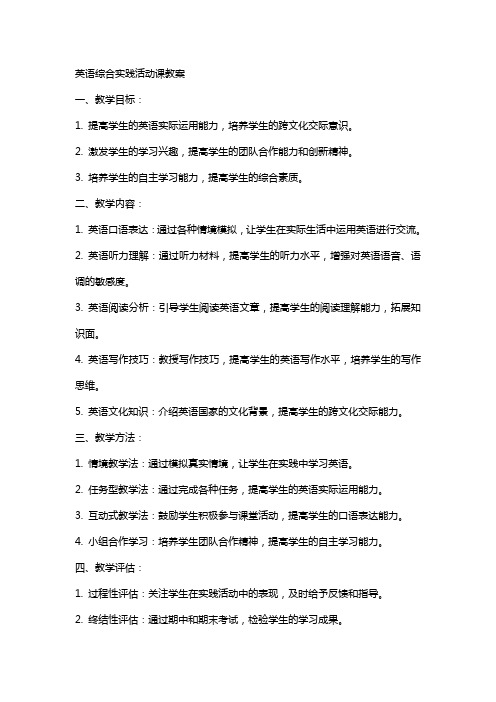
英语综合实践活动课教案一、教学目标:1. 提高学生的英语实际运用能力,培养学生的跨文化交际意识。
2. 激发学生的学习兴趣,提高学生的团队合作能力和创新精神。
3. 培养学生的自主学习能力,提高学生的综合素质。
二、教学内容:1. 英语口语表达:通过各种情境模拟,让学生在实际生活中运用英语进行交流。
2. 英语听力理解:通过听力材料,提高学生的听力水平,增强对英语语音、语调的敏感度。
3. 英语阅读分析:引导学生阅读英语文章,提高学生的阅读理解能力,拓展知识面。
4. 英语写作技巧:教授写作技巧,提高学生的英语写作水平,培养学生的写作思维。
5. 英语文化知识:介绍英语国家的文化背景,提高学生的跨文化交际能力。
三、教学方法:1. 情境教学法:通过模拟真实情境,让学生在实践中学习英语。
2. 任务型教学法:通过完成各种任务,提高学生的英语实际运用能力。
3. 互动式教学法:鼓励学生积极参与课堂活动,提高学生的口语表达能力。
4. 小组合作学习:培养学生团队合作精神,提高学生的自主学习能力。
四、教学评估:1. 过程性评估:关注学生在实践活动中的表现,及时给予反馈和指导。
2. 终结性评估:通过期中和期末考试,检验学生的学习成果。
3. 自我评估:鼓励学生进行自我反思,提高学生的自我学习能力。
五、教学资源:1. 教材:选用适合学生水平的英语教材,提供丰富的学习资源。
2. 多媒体设备:利用多媒体课件,增加课堂趣味性,提高教学效果。
3. 网络资源:利用网络资源,拓宽学生的学习渠道,提高学生的自主学习能力。
4. 实物教具:使用实物教具,增强学生的直观感受,提高教学效果。
六、教学进程安排:1. 第一阶段:英语口语表达训练(2周)通过情境模拟、角色扮演等方式,让学生在实际生活中运用英语进行交流。
2. 第二阶段:英语听力理解训练(2周)选用不同主题的听力材料,提高学生的听力水平,增强对英语语音、语调的敏感度。
3. 第三阶段:英语阅读分析训练(2周)引导学生阅读英语文章,提高学生的阅读理解能力,拓展知识面。
英语综合实践活动课教案

英语综合实践活动课教案一、教学目标:1. 提高学生对英语的综合运用能力,培养学生的英语核心素养。
2. 激发学生的学习兴趣,培养学生主动探索、合作学习的习惯。
3. 增强学生的跨文化交际意识,提高学生的跨文化交际能力。
4. 培养学生运用英语进行实际生活、工作和学习中解决问题的能力。
二、教学内容:1. 生活场景对话:以日常生活中的购物、问路、就餐等场景为背景,进行角色扮演和情景模拟。
2. 商务交际:学习商务场合中的问候、介绍、会议、商务宴请等交际用语。
3. 旅游英语:针对旅游活动中的预订、咨询、游览、购物等环节,学习相关的表达方式和实用句型。
4. 英语辩论:围绕热点话题,培养学生进行英语辩论的能力,提高学生的逻辑思维和口头表达能力。
5. 跨文化交际:学习不同文化背景下的交际习惯和表达方式,提高学生的跨文化交际意识。
三、教学方法:1. 任务驱动法:通过设定具体任务,引导学生参与实践活动,提高学生的实际运用能力。
2. 情境教学法:创设真实的语言环境,让学生在实际情境中感受、理解和运用英语。
3. 合作学习法:鼓励学生分组讨论、合作完成任务,培养学生的团队协作能力。
4. 案例分析法:通过分析典型病例,引导学生学会运用英语进行分析和解决问题。
四、教学评价:1. 过程性评价:关注学生在实践活动中的表现,及时给予指导和反馈。
2. 终结性评价:定期进行英语综合能力测试,检验学生的学习成果。
3. 自我评价:鼓励学生对自己的学习过程和成果进行反思,提高自我认知。
五、教学计划:1. 第1-2周:生活场景对话教学,培养学生日常英语交际能力。
2. 第3-4周:商务交际教学,提高学生在商务场合的英语运用能力。
3. 第5-6周:旅游英语教学,培养学生旅游活动中的英语表达能力。
4. 第7-8周:英语辩论教学,提升学生的逻辑思维和口头表达能力。
5. 第9-10周:跨文化交际教学,增强学生的跨文化交际意识。
六、教学活动设计:1. 生活场景对话实践活动:组织学生进行角色扮演,模拟现实生活中购物、问路、就餐等场景,让学生在实际操作中运用所学英语。
英语综合实践活动课教案

英语综合实践活动课教案一、教学目标:1. 提高学生运用英语进行交流的能力,增强学生的英语实践应用能力。
2. 培养学生的团队合作精神,提升学生的综合素质。
3. 激发学生学习英语的兴趣,提高学生的英语水平。
二、教学内容:1. 英语口语表达:通过各种情景模拟,让学生在实际生活中运用英语进行交流。
2. 英语听力理解:通过听力练习,提高学生对英语语音、语调的识别和理解能力。
3. 英语文化背景知识:介绍英语国家的文化、风俗、习惯等,让学生了解并感受英语文化的魅力。
三、教学方法:1. 情境教学法:通过模拟真实的生活场景,让学生在实践中学习英语。
2. 任务型教学法:通过完成各种任务,激发学生的学习兴趣和积极性。
3. 交际法:鼓励学生主动参与课堂交流,提高学生的英语口语表达能力。
四、教学评价:1. 过程性评价:关注学生在实践活动中的表现,以鼓励和指导为主。
2. 终结性评价:通过测试、表演等形式,评估学生的学习成果。
3. 自我评价:鼓励学生对自己的学习过程和成果进行反思和评价。
五、教学活动:1. 热身活动:引导学生进行简单的英语自我介绍,营造轻松的课堂氛围。
2. 实践活动:根据不同主题,设计各种英语实践活动,如角色扮演、小组讨论等。
3. 听力练习:选择适合学生水平的英语听力材料,进行听力训练。
4. 文化讲解:介绍相关英语国家的文化背景,让学生了解并感受英语文化的魅力。
5. 总结与反馈:对学生的实践活动进行总结和评价,鼓励学生继续努力。
六、教学准备:1. 教材:选择适合学生的英语综合实践活动教材或自编教材。
2. 教学资源:准备相关的听力材料、文化背景知识资料、实践活动指导资料等。
3. 教学设备:投影仪、电脑、音响等教学设备。
七、教学步骤:1. 导入:通过热身活动,引导学生进入英语学习状态。
2. 教学内容展示:介绍本节课的主题和教学内容。
3. 实践活动:分组进行实践活动,教师巡回指导。
4. 听力练习:播放听力材料,学生完成相关练习。
英语综合实践课教案
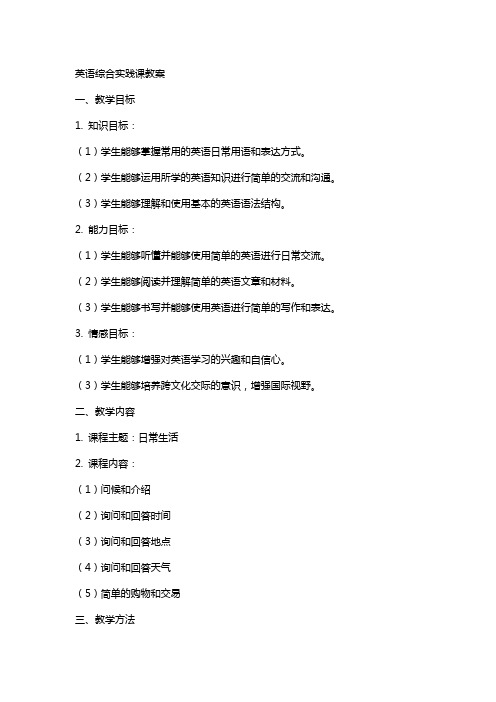
英语综合实践课教案一、教学目标1. 知识目标:(1)学生能够掌握常用的英语日常用语和表达方式。
(2)学生能够运用所学的英语知识进行简单的交流和沟通。
(3)学生能够理解和使用基本的英语语法结构。
2. 能力目标:(1)学生能够听懂并能够使用简单的英语进行日常交流。
(2)学生能够阅读并理解简单的英语文章和材料。
(3)学生能够书写并能够使用英语进行简单的写作和表达。
3. 情感目标:(1)学生能够增强对英语学习的兴趣和自信心。
(3)学生能够培养跨文化交际的意识,增强国际视野。
二、教学内容1. 课程主题:日常生活2. 课程内容:(1)问候和介绍(2)询问和回答时间(3)询问和回答地点(4)询问和回答天气(5)简单的购物和交易三、教学方法1. 交际法:通过模拟真实情境,让学生在实际交流中学习和使用英语。
2. 任务型教学法:通过完成具体的任务,让学生在实践中学习和运用英语。
3. 合作学习法:通过小组合作和互动,让学生在交流中学习,提高语言运用能力。
四、教学步骤1. 热身活动(5分钟):通过简单的英语歌曲或游戏,让学生放松气氛,调动学习积极性。
2. 课程导入(10分钟):教师引导学生复习已学的相关知识,为新课程的学习做好铺垫。
3. 新课程学习(20分钟):教师讲解新的知识点,并通过示例、练习等方式让学生进行实际操作和练习。
4. 实践环节(15分钟):学生分组进行角色扮演或完成任务,运用所学知识进行实际交流。
5. 总结与反馈(5分钟):教师对学生的表现进行点评和反馈,指出优点和需要改进的地方。
五、教学评价1. 过程评价:观察学生在课堂上的参与程度、态度和表现,以及对任务的完成情况进行评价。
2. 结果评价:通过定期的测试和考试,评估学生对知识的掌握程度和运用能力。
3. 自我评价:鼓励学生进行自我反思和评价,培养学生的自我学习能力。
六、教学资源1. 教材:选用适合学生水平的英语综合实践课教材。
2. 辅助材料:提供相关的图片、图表、音频、视频等资源,以丰富教学内容。
小学英语综合实践课教案计划范本
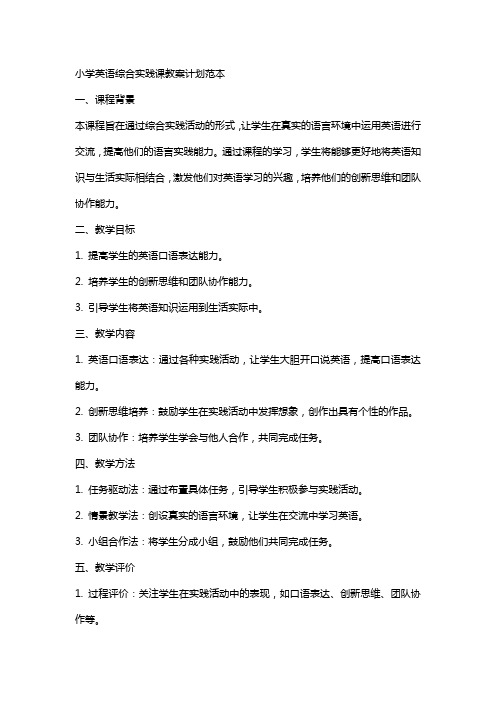
小学英语综合实践课教案计划范本一、课程背景本课程旨在通过综合实践活动的形式,让学生在真实的语言环境中运用英语进行交流,提高他们的语言实践能力。
通过课程的学习,学生将能够更好地将英语知识与生活实际相结合,激发他们对英语学习的兴趣,培养他们的创新思维和团队协作能力。
二、教学目标1. 提高学生的英语口语表达能力。
2. 培养学生的创新思维和团队协作能力。
3. 引导学生将英语知识运用到生活实际中。
三、教学内容1. 英语口语表达:通过各种实践活动,让学生大胆开口说英语,提高口语表达能力。
2. 创新思维培养:鼓励学生在实践活动中发挥想象,创作出具有个性的作品。
3. 团队协作:培养学生学会与他人合作,共同完成任务。
四、教学方法1. 任务驱动法:通过布置具体任务,引导学生积极参与实践活动。
2. 情景教学法:创设真实的语言环境,让学生在交流中学习英语。
3. 小组合作法:将学生分成小组,鼓励他们共同完成任务。
五、教学评价1. 过程评价:关注学生在实践活动中的表现,如口语表达、创新思维、团队协作等。
2. 成果评价:对学生的作品进行评价,考察他们的学习成果。
3. 自我评价:鼓励学生反思自己的学习过程,提高自我认知。
六、教学准备1. 教材:选用适合小学生的英语教材,如《新概念英语》或《牛津英语》。
2. 教具:准备相关教学辅助材料,如PPT、卡片、图片等。
3. 场地:选择一个宽敞的教室或户外场所,以便进行实践活动。
七、教学步骤1. 热身活动:通过简单的英语歌曲或游戏,引导学生进入学习状态。
2. 实践活动:布置具体任务,引导学生分组进行实践。
如:角色扮演、小组讨论、制作手工艺品等。
3. 语言讲解:在实践活动过程中,适时进行英语语言知识的讲解和辅导。
4. 总结与展示:让学生展示实践活动成果,并进行点评和总结。
八、教学案例案例一:以“我的家庭”为主题,让学生用英语介绍自己的家庭成员。
学生分组进行角色扮演,模拟家庭场景,用英语进行交流。
综合实践课教学设计英语(3篇)

第1篇1. 知识与技能:(1)学生能够熟练掌握并运用所学的英语词汇和句型。
(2)学生能够运用所学知识进行简单的英语对话和交流。
2. 过程与方法:(1)通过小组合作、角色扮演等活动,提高学生的英语口语表达能力。
(2)通过情景模拟,让学生在真实的语境中运用英语。
3. 情感态度与价值观:(1)培养学生对英语学习的兴趣,增强学习英语的自信心。
(2)培养学生尊重他人、团结协作的精神。
二、教学内容1. 词汇:weather、weather forecast、temperature、wind、rain、sunny、cloudy、snowy等。
2. 句型:What's the weather like today? It's sunny/rainy/cloudy/snowy. How's the temperature? It's cold/hot. What's the wind like? It's strong/weak.三、教学过程1. 导入(1)教师播放一段关于天气的英文歌曲,激发学生的兴趣。
(2)教师提问:What's the song about? 引导学生回答:The weather.2. 词汇教学(1)教师展示天气相关的词汇卡片,引导学生说出单词的发音和意思。
(2)学生分组,每组选择一个天气词汇,进行角色扮演,展示如何用该词汇进行对话。
3. 句型教学(1)教师展示句型卡片,引导学生说出句子的意思和用法。
(2)学生分组,每组选择一个句型,进行角色扮演,展示如何运用句型进行对话。
4. 情景模拟(1)教师创设一个关于天气的情景,如:Today is Saturday. It's sunny. What are you going to do? 引导学生运用所学知识进行对话。
(2)学生分组,每组根据教师提供的情景,进行角色扮演,展示如何运用所学知识进行对话。
英语综合实践课教案

英语综合实践课教案一、教学目标1. 知识目标:(1)学生能够运用所学的英语词汇和语法知识进行日常交流。
(2)学生能够理解并运用常见的英语表达方式进行描述和阐述。
2. 技能目标:(1)学生能够听懂并能够运用英语进行简单的对话。
(2)学生能够阅读并理解简单的英语文章。
(3)学生能够运用英语进行写作和口头表达。
3. 情感目标:(1)培养学生对英语学习的兴趣和积极性。
(2)培养学生的团队合作意识和沟通能力。
二、教学内容1. 第一课时:英语自我介绍(1)学习并运用基本的英语问候语进行自我介绍。
(2)练习并掌握基本的个人信息介绍的句型和表达方式。
2. 第二课时:日常英语对话(1)学习并运用常见的英语日常用语进行交流。
(2)练习并掌握简单的日常对话结构和表达方式。
3. 第三课时:英语介绍家乡(1)学习并运用描述家乡的英语词汇和句型。
(2)练习并掌握介绍家乡的表达方式和结构。
4. 第四课时:英语讲述故事(1)学习并运用讲述故事的英语词汇和句型。
(2)练习并掌握讲述故事的表达方式和结构。
5. 第五课时:英语讨论兴趣和爱好三、教学方法1. 情境教学法:通过设定各种真实的语境,让学生在实际的语言环境中学习和应用英语。
2. 交际教学法:通过模拟真实的交流场景,让学生在互动和对话中学习和应用英语。
3. 任务型教学法:通过完成各种实际的英语任务,让学生在实践中学习和应用英语。
四、教学评价1. 课堂参与度:观察学生在课堂上的参与情况和积极性。
2. 语言运用能力:通过口语表达和写作练习评估学生的语言运用能力。
3. 学习效果:通过测试和作业评估学生的学习效果和掌握程度。
五、教学资源1. 教材:英语综合实践课教材。
2. 教具:投影仪、电脑、黑板、粉笔等。
3. 辅助材料:英语对话剧本、故事素材、兴趣和爱好相关的话题等。
六、第六课时:英语描述人物1. 学习并运用描述人物的外貌、性格和能力的英语词汇和句型。
2. 练习并掌握描述人物的表达方式和结构。
小学英语综合实践活动教案

小学英语综合实践活动教案一、活动主题:英语角——介绍我的家人二、活动目标:1. 学生能够用英语简单介绍自己的家人。
2. 学生能够听懂并运用常见的家庭成员词汇。
3. 提高学生的口语表达能力和团队合作意识。
三、活动准备:1. 教师准备家庭成员词汇卡片。
2. 学生准备家庭成员照片或手工作品。
四、活动过程:1. 热身活动(5分钟):唱一首关于家庭的英文歌曲,如《Family Tree》。
2. 家庭成员词汇学习(10分钟):教师分发词汇卡片,引导学生学习家庭成员词汇,如mother, father, sister, brother等。
3. 小组活动(15分钟):学生分成小组,每组选择一张家庭成员照片或手工作品,用英语介绍自己的家人,其他小组成员倾听并给予反馈。
4. 展示环节(10分钟):每个小组派代表上台,向全班同学介绍自己的家人,其他同学听后进行评价。
5. 总结环节(5分钟):教师对学生的表现进行点评,强调口语表达的重要性和团队合作的精神。
五、作业布置:1. 学生回家后,尝试用英语向家人介绍自己的家人,并记录下来。
2. 学生准备一首关于家庭的英文歌曲,下节课分享。
六、活动主题:英语角——我的学校生活七、活动目标:1. 学生能够用英语描述自己的学校生活。
2. 学生能够听懂并运用常见的学校相关词汇。
3. 提高学生的口语表达能力和团队合作意识。
八、活动准备:1. 教师准备学校相关词汇卡片。
2. 学生准备学校照片或手工作品。
九、活动过程:1. 热身活动(5分钟):唱一首关于学校的英文歌曲,如《Going to School》。
2. 学校相关词汇学习(10分钟):教师分发词汇卡片,引导学生学习学校相关词汇,如classroom, teacher, student, school等。
3. 小组活动(15分钟):学生分成小组,每组选择一张学校照片或手工作品,用英语描述自己的学校生活,其他小组成员倾听并给予反馈。
4. 展示环节(10分钟):每个小组派代表上台,向全班同学介绍自己的学校生活,其他同学听后进行评价。
小学英语综合实践课英语综合实践课教案

小学英语综合实践课教案教学目标:1. 培养学生的英语听、说、读、写能力,提高英语综合运用能力。
2. 培养学生的团队协作精神和沟通能力。
3. 激发学生对英语学习的兴趣和积极性。
教学重点:1. 通过实践活动,让学生在实际情境中运用英语进行交流。
2. 培养学生的英语思维能力和创新意识。
教学难点:1. 学生在实际情境中运用英语进行交流的能力。
2. 学生对英语词汇和语法的掌握程度。
教学准备:1. 教材、教学课件、教学道具等。
2. 分组,每组45人,确保每个学生都能参与到实践活动中。
教学过程:一、导入1. 教师通过播放一段与主题相关的英语视频,激发学生的兴趣。
2. 教师引导学生讨论视频内容,并引出本节课的主题。
二、实践活动1. 教师将学生分成小组,每组选择一个主题进行实践。
2. 各小组在教师的指导下,通过查阅资料、讨论、制作PPT等方式,完成实践任务。
3. 各小组向全班展示实践成果,并进行小组互评。
2. 学生分享自己在实践中的体会和感受,提出改进意见。
3. 教师对学生的表现进行评价,鼓励学生在今后的学习中继续努力。
四、作业布置1. 教师布置与本节课主题相关的英语写作任务,要求学生运用所学知识进行创作。
2. 学生在课后完成作业,并上交给教师批改。
教学反思:本节课通过实践活动,让学生在实际情境中运用英语进行交流,培养了学生的英语听、说、读、写能力。
同时,通过小组合作,培养了学生的团队协作精神和沟通能力。
在教学过程中,教师应关注学生的学习状态,及时给予指导和帮助,确保每个学生都能参与到实践活动中。
在今后的教学中,教师应继续探索和实践有效的教学方法,提高学生的英语综合运用能力。
教学过程(续):五、拓展延伸1. 教师引导学生思考如何将本节课所学知识应用到日常生活中。
2. 学生分享自己的见解和想法,教师给予鼓励和指导。
3. 教师布置拓展任务,要求学生运用所学知识解决实际问题。
六、课后辅导1. 教师针对学生在课堂上的表现,给予个性化的辅导和建议。
英语综合实践活动课教案
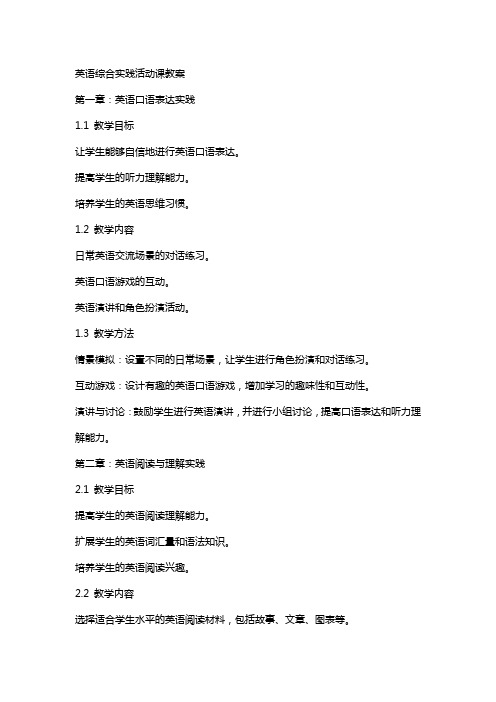
英语综合实践活动课教案第一章:英语口语表达实践1.1 教学目标让学生能够自信地进行英语口语表达。
提高学生的听力理解能力。
培养学生的英语思维习惯。
1.2 教学内容日常英语交流场景的对话练习。
英语口语游戏的互动。
英语演讲和角色扮演活动。
1.3 教学方法情景模拟:设置不同的日常场景,让学生进行角色扮演和对话练习。
互动游戏:设计有趣的英语口语游戏,增加学习的趣味性和互动性。
演讲与讨论:鼓励学生进行英语演讲,并进行小组讨论,提高口语表达和听力理解能力。
第二章:英语阅读与理解实践2.1 教学目标提高学生的英语阅读理解能力。
扩展学生的英语词汇量和语法知识。
培养学生的英语阅读兴趣。
2.2 教学内容选择适合学生水平的英语阅读材料,包括故事、文章、图表等。
通过阅读活动,帮助学生理解和分析文章的主旨、细节和作者的观点。
进行词汇和语法练习,巩固学生的语言知识。
2.3 教学方法阅读理解:让学生阅读给定的材料,并通过问题回答来检验理解程度。
词汇和语法练习:针对阅读材料中的重点词汇和语法点进行练习和讲解。
小组讨论:鼓励学生进行小组讨论,分享阅读心得和理解。
第三章:英语写作与创作实践3.1 教学目标培养学生的英语写作能力。
提高学生的创意思维和表达能力。
帮助学生掌握写作的基本技巧和结构。
3.2 教学内容写作练习:根据不同的话题,让学生进行英语写作练习。
创意写作:鼓励学生发挥创造力,进行故事、诗歌或其他形式的创作。
写作技巧和结构的学习:教授学生写作的基本技巧和文章结构。
3.3 教学方法写作指导:通过示例和指导,帮助学生掌握写作技巧和结构。
创意激发:通过讨论和启发,激发学生的创意思维。
自评和互评:鼓励学生进行自我评价和同伴评价,提高写作能力。
第四章:英语听力理解实践4.1 教学目标提高学生的英语听力理解能力。
增强学生的语音和语调感知能力。
培养学生的英语听力习惯。
4.2 教学内容听力材料的选择:选择适合学生水平的英语听力材料,包括对话、故事、讲座等。
英语综合实践活动课教案
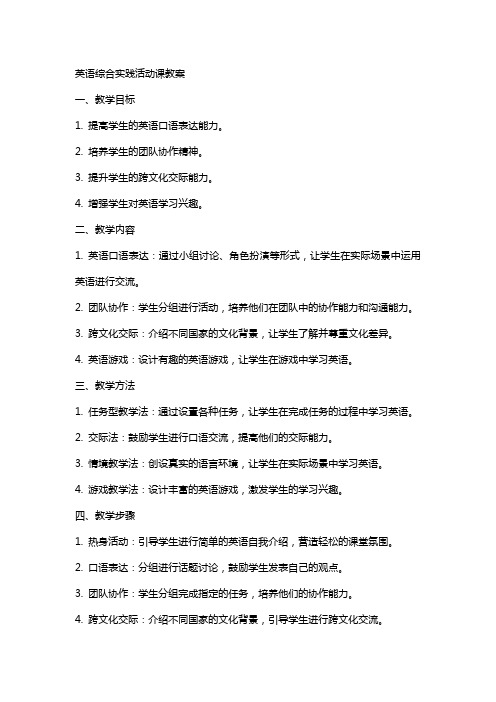
英语综合实践活动课教案一、教学目标1. 提高学生的英语口语表达能力。
2. 培养学生的团队协作精神。
3. 提升学生的跨文化交际能力。
4. 增强学生对英语学习兴趣。
二、教学内容1. 英语口语表达:通过小组讨论、角色扮演等形式,让学生在实际场景中运用英语进行交流。
2. 团队协作:学生分组进行活动,培养他们在团队中的协作能力和沟通能力。
3. 跨文化交际:介绍不同国家的文化背景,让学生了解并尊重文化差异。
4. 英语游戏:设计有趣的英语游戏,让学生在游戏中学习英语。
三、教学方法1. 任务型教学法:通过设置各种任务,让学生在完成任务的过程中学习英语。
2. 交际法:鼓励学生进行口语交流,提高他们的交际能力。
3. 情境教学法:创设真实的语言环境,让学生在实际场景中学习英语。
4. 游戏教学法:设计丰富的英语游戏,激发学生的学习兴趣。
四、教学步骤1. 热身活动:引导学生进行简单的英语自我介绍,营造轻松的课堂氛围。
2. 口语表达:分组进行话题讨论,鼓励学生发表自己的观点。
3. 团队协作:学生分组完成指定的任务,培养他们的协作能力。
4. 跨文化交际:介绍不同国家的文化背景,引导学生进行跨文化交流。
5. 英语游戏:组织学生参与英语游戏,提高他们的学习兴趣。
五、作业与评价2. 评价:教师对学生的课堂表现进行评价,关注他们的口语表达、团队协作和跨文化交际能力。
3. 反馈:及时给予学生反馈,鼓励他们不断提高。
六、教学资源1. 教材:选用适合学生的英语综合实践活动教材。
2. 多媒体设备:投影仪、电脑、音响等。
3. 教具:图片、卡片、实物等。
4. 网络资源:相关英语学习网站、视频等。
七、教学环境1. 教室布局:座位排列便于学生交流和互动。
2. 氛围营造:轻松、愉快的课堂氛围,鼓励学生积极参与。
3. 设施设备:确保多媒体设备正常运行,网络畅通。
八、教学评价1. 过程评价:关注学生在课堂活动中的参与程度、口语表达和团队协作能力。
2. 成果评价:评价学生课后作业,了解他们对课堂所学内容的掌握情况。
2024年小学英语综合实践活动计划(五篇)

2024年小学英语综合实践活动计划一、教学理念兴趣作为学生学习的内在动力,对于培养英语学习热情至关重要。
鉴于小学阶段英语学习环境的局限性,学生往往面临记忆遗忘的挑战,出现“学时记得、用时忘记”的现象。
这种现象若长期存在,可能导致部分学生成绩下滑,逐渐丧失对英语学习的兴趣,进而影响教师的教学质量。
因此,小学英语教学应着眼于学生的实际需求,同时关注其未来学习与发展。
仅仅依赖课堂内的教学无法充分满足学生学习英语的需求,我们需树立以大课堂为核心的教学观念,并重视课外实践活动的开展。
课外活动作为课堂教学的辅助与延伸,对于培养学生学习兴趣至关重要。
为此,我们特开展小学英语综合实践活动,旨在丰富学生的课余生活。
二、活动宗旨1. 通过组织有效的课外活动,从小培养小学生对英语及其学习的浓厚兴趣。
2. 教授学生学习方法,培养其英语学习能力,实现“授人以渔”的教学目标。
3. 培养学生良好的行为习惯,塑造健康的个性心理。
4. 提升学生的综合素质,为未来英语学习打下坚实基础。
三、活动内容本学期,我们将通过“绿色作业”这一形式开展学科实践活动。
学生通过参与绿色作业的实践与完成,不仅能够丰富英语知识,还能显著提升学习兴趣,拓宽思维视野,并从英语的视角发现世界的多样性。
四、活动范围活动对象涵盖一至六年级全体学生。
五、参与要求每位学生均需按时参加综合实践活动,并在活动中积极投入,展现出团结协作的精神。
六、实施措施英语教研组将依据教材内容,设计合理且有效的绿色作业。
学生需自主认真完成各自分配的绿色作业,教师将从中挑选优秀作业进行展评。
学生的作业完成情况将作为其英语成绩的组成部分,以激励学生积极参与并认真对待综合实践活动。
2024年小学英语综合实践活动计划(二)本计划旨在贯彻落实培养学生综合素质的教育方针,特制定小学英语综合实践活动方案,以期激发学生的学习兴趣,增强学习积极性,并丰富课余生活。
一、指导思想本活动秉承培养学生学习英语兴趣的宗旨,通过多元化的实践活动,旨在激发小学生对英语学习的热情,同时充实其课余生活。
英语实践活动方案5篇

英语实践活动方案5篇(经典版)编制人:__________________审核人:__________________审批人:__________________编制单位:__________________编制时间:____年____月____日序言下载提示:该文档是本店铺精心编制而成的,希望大家下载后,能够帮助大家解决实际问题。
文档下载后可定制修改,请根据实际需要进行调整和使用,谢谢!并且,本店铺为大家提供各种类型的经典范文,如工作总结、学习总结、工作计划、活动方案、条据文书、规章制度、应急预案、教学资料、作文大全、其他范文等等,想了解不同范文格式和写法,敬请关注!Download tips: This document is carefully compiled by this editor. I hope that after you download it, it can help you solve practical problems. The document can be customized and modified after downloading, please adjust and use it according to actual needs, thank you!Moreover, the shop provides you with various types of classic model essays, such as work summary, study summary, work plan, activity plan, documents, rules and regulations, emergency plans, teaching materials, composition, other model essays, etc.want to know different model essay formats and writing methods, please pay attention!英语实践活动方案5篇我们写活动方案的目的就是为了让我们的活动更加有趣,活动方案的创新性能够吸引参与者的兴趣和关注,下面是本店铺为您分享的英语实践活动方案5篇,感谢您的参阅。
英语综合实践课教学案例(3篇)
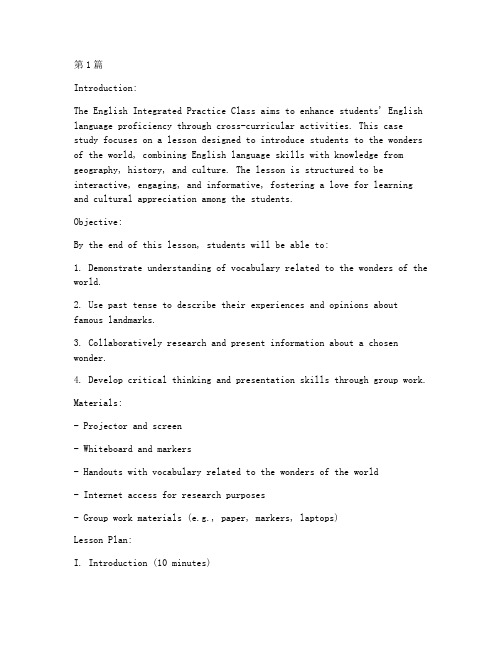
第1篇Introduction:The English Integrated Practice Class aims to enhance students' English language proficiency through cross-curricular activities. This case study focuses on a lesson designed to introduce students to the wonders of the world, combining English language skills with knowledge from geography, history, and culture. The lesson is structured to be interactive, engaging, and informative, fostering a love for learning and cultural appreciation among the students.Objective:By the end of this lesson, students will be able to:1. Demonstrate understanding of vocabulary related to the wonders of the world.2. Use past tense to describe their experiences and opinions about famous landmarks.3. Collaboratively research and present information about a chosen wonder.4. Develop critical thinking and presentation skills through group work.Materials:- Projector and screen- Whiteboard and markers- Handouts with vocabulary related to the wonders of the world- Internet access for research purposes- Group work materials (e.g., paper, markers, laptops)Lesson Plan:I. Introduction (10 minutes)1. Start the class with a warm-up activity: "Name as many wonders of the world as you can in one minute."2. Discuss the importance of exploring the world and its impact on personal growth and cultural understanding.3. Introduce the topic of the lesson: "Exploring the Wonders of the World."II. Vocabulary Building (15 minutes)1. Present a list of vocabulary related to the wonders of the world(e.g., pyramid, canyon, castle, temple).2. Use flashcards and interactive games to reinforce the vocabulary.3. Have students create sentences using the new vocabulary.III. Group Research and Presentation (30 minutes)1. Divide the class into groups of four.2. Assign each group a wonder of the world (e.g., the Great Wall of China, the Colosseum, the Grand Canyon).3. Provide each group with a list of research questions and guidelines for their presentation.4. Allow students to use the internet and other resources to gather information about their chosen wonder.IV. Presentation and Group Discussion (30 minutes)1. Each group presents their findings to the class using visual aids(e.g., PowerPoint slides, handouts).2. After each presentation, allow time for questions and answers from the class.3. Facilitate a group discussion about the similarities and differences between the wonders of the world.4. Encourage students to share their personal experiences or aspirations related to traveling and exploring.V. Creative Writing Activity (20 minutes)1. Have students write a short essay describing their favorite wonder of the world and why they find it fascinating.2. Provide writing prompts and guidance to help students structure their essays.3. Allow time for peer editing and feedback.VI. Conclusion and Assessment (10 minutes)1. Summarize the key points discussed during the lesson.2. Assess students' understanding of the vocabulary and their ability to use past tense in their essays.3. Provide feedback and constructive criticism for each student's essay and group presentation.Assessment:- Students' participation and engagement in class activities.- Accuracy and creativity in the use of vocabulary related to the wonders of the world.- Quality and clarity of the group presentations.- Completion and quality of the creative writing essays.Reflection:This lesson was a success as it allowed students to explore the wonders of the world through various cross-curricular activities. The students were highly engaged and showed enthusiasm for the topic. The use of technology and group work enhanced their learning experience. As a teacher, I observed that the students developed a deeper appreciationfor different cultures and places. This lesson served as a stepping stone for further exploration and understanding of the world around them.Conclusion:The English Integrated Practice Class, with its focus on the wonders of the world, provided a rich and immersive learning experience for the students. By combining language skills with knowledge from other disciplines, the lesson not only enhanced their English proficiency but also fostered a global perspective and a passion for learning.第2篇Introduction:English comprehensive practice classes aim to enhance students' overall English proficiency by integrating listening, speaking, reading, and writing skills. This case study focuses on a teaching session designed for intermediate-level students, with the objective of fosteringcultural awareness and global understanding through English. The lesson utilizes a variety of activities, technology, and real-world contexts to engage students actively.Context:The class consists of 30 intermediate-level students aged 14-16. They have been studying English for about three years and have a basic understanding of grammar and vocabulary. The school is in a suburban area, and the students come from diverse cultural backgrounds.Objectives:1. To improve students' listening and speaking skills throughinteractive discussions.2. To enhance students' reading and writing skills by analyzing and summarizing global news articles.3. To develop cultural awareness and global understanding through the exploration of different countries and cultures.4. To encourage critical thinking and the ability to express opinions on global issues.Materials:1. Projector and screen for displaying PowerPoint presentations and videos.2. Computers with internet access for research.3. Handouts with news articles and discussion questions.4. Whiteboard and markers.5. Language learning apps for vocabulary practice.Teaching Procedure:1. Warm-up (10 minutes):- Begin with a quick review of the previous lesson's vocabulary using a game called "Pictionary."- Ask students to draw and guess words related to global cultures, such as "Eiffel Tower," "Sambadance," "Great Wall," etc.2. Introduction to the lesson (5 minutes):- Introduce the theme of the lesson: "Exploring the World Through English."- Explain the objectives of the lesson and the activities that will be conducted.3. Listening and Speaking Activity (15 minutes):- Play a short video clip about a different country or culture, such as "The Great Barrier Reef in Australia."- Pause the video at key moments and ask students to summarize what they have just seen.- Divide the class into small groups and assign each group a different country or culture to research.- Each group will prepare a short presentation to share with the class, focusing on the culture, history, and interesting facts about their chosen country.4. Reading and Writing Activity (20 minutes):- Distribute handouts with a news article about a global issue, such as climate change or human rights.- Ask students to read the article silently and take notes on key points.- Divide the class into pairs and ask them to discuss their opinions on the issue and write a short summary of the article.- Each pair will present their summary to the class and engage in a group discussion about the topic.5. Cultural Awareness Activity (15 minutes):- Use a PowerPoint presentation to showcase different cultural symbols, such as traditional clothing, food, or music.- Ask students to identify the country or culture each symbol belongs to and share their knowledge about it.- Conduct a "Jeopardy" game where students answer questions about different countries and cultures.6. Reflection and Conclusion (10 minutes):- Ask students to reflect on what they have learned during the lesson and how they can apply their knowledge in real life.- Summarize the key points of the lesson and encourage students to continue exploring global cultures outside the classroom.Assessment:- Observe students' participation and engagement during the activities.- Evaluate the quality of students' presentations, summaries, and discussions.- Collect and review students' written work for grammar, vocabulary, and content accuracy.Conclusion:This English comprehensive practice class effectively integrated listening, speaking, reading, and writing skills to foster cultural awareness and global understanding among intermediate-level students. By using a variety of activities, technology, and real-world contexts, the lesson encouraged active learning and critical thinking. The students demonstrated significant progress in their language skills and cultural knowledge, which will undoubtedly contribute to their overall development as global citizens.第3篇IntroductionThe English Comprehensive Practice Class is designed to enhancestudents' practical English skills, including listening, speaking, reading, and writing. This case study focuses on a lesson thatintegrates various teaching methods and activities to ensure an engaging and effective learning experience for the students.ContextThe lesson takes place in a secondary school in China, with a class of 40 students aged 14-15. The students have a basic understanding of English grammar and vocabulary but are at different levels ofproficiency in practical English communication. The lesson duration is 90 minutes.Objectives1. To improve students' listening and speaking skills through real-life conversations.2. To enhance students' reading comprehension through a variety of texts.3. To encourage students to write short essays on a given topic.4. To foster students' critical thinking and collaborative learning skills.Materials1. Audio-visual equipment (projector, computer, speakers)2. Handouts with listening exercises and reading texts3. Writing materials (pens, paper)4. Whiteboard and markers5. A set of flashcards with vocabulary related to the topicTeaching ProcedureWarm-up (10 minutes)- The teacher begins the class with a brief icebreaker activity: "Good morning, everyone! Can you tell me something about your weekend?" This encourages students to use English in a casual and informal setting.- Next, the teacher displays a set of flashcards with vocabulary related to the lesson topic (e.g., "hobbies," "sports," "travel"). Students are asked to work in pairs to create a short dialogue using the vocabulary.Listening Activity (15 minutes)- The teacher plays a short audio clip related to the lesson topic, such as a conversation between two friends discussing their favorite hobbies. Students are asked to listen carefully and answer comprehension questions.- After listening, the teacher invites students to share their answers and discuss the content of the audio clip.Speaking Activity (20 minutes)- The teacher divides the class into small groups and assigns each group a different topic related to the lesson (e.g., "My favorite sport," "Amemorable trip"). Each group is given a set of questions to guide their discussion.- The groups have 10 minutes to prepare their presentations. They are encouraged to use the vocabulary from the flashcards and the information from the listening activity.- Each group presents their discussion to the class, and the teacher provides feedback and encouragement.Reading Activity (15 minutes)- The teacher distributes handouts with a reading text related to the lesson topic. The text includes a variety of comprehension questions to test the students' understanding.- Students work individually to answer the questions, and then discuss their answers with their partners.- The teacher reviews the answers and discusses any misconceptions or misunderstandings.Writing Activity (20 minutes)- The teacher introduces a writing prompt related to the lesson topic (e.g., "Describe a memorable event in your life"). Students are asked to write a short essay on the prompt.- The teacher provides guidance on essay structure and writing techniques, emphasizing the importance of clear organization and coherent ideas.- Students write their essays, and the teacher circulates the room to provide individual feedback.Conclusion (10 minutes)- The teacher summarizes the main points of the lesson and encourages students to reflect on what they have learned.- Students are asked to share one thing they found challenging or interesting during the lesson.- The teacher ends the class with a positive note, emphasizing the importance of practice and perseverance in learning English.Assessment- The teacher assesses students' participation in activities, thequality of their oral presentations, their comprehension of the reading text, and the effectiveness of their writing.- A rubric is used to evaluate each student's performance in each activity.ReflectionThis English Comprehensive Practice Class effectively integrated various teaching methods and activities to enhance students' practical English skills. The use of real-life conversations, group work, and individual writing tasks allowed students to practice and apply their knowledge in a meaningful way. The teacher's positive feedback and encouragement fostered a supportive learning environment, which motivated students to engage actively in the lesson. Overall, the lesson was successful in achieving its objectives and providing a valuable learning experiencefor the students.。
- 1、下载文档前请自行甄别文档内容的完整性,平台不提供额外的编辑、内容补充、找答案等附加服务。
- 2、"仅部分预览"的文档,不可在线预览部分如存在完整性等问题,可反馈申请退款(可完整预览的文档不适用该条件!)。
- 3、如文档侵犯您的权益,请联系客服反馈,我们会尽快为您处理(人工客服工作时间:9:00-18:30)。
活动一:“生日快乐”活动目的:1.让学生学会如何描绘自己的生日。
2.学生能够互祝“生日快乐”。
3.相互之间增进友谊。
活动设计:一、介绍词汇教师在介绍和讲解重要词汇时,手指着每个月。
1、让学生翻开课本。
2、教师放录音,学生听并指着每个月。
3、教师再放一遍录音,学生听并重复。
二、对话1、教师放录音,学生听并指着每个人。
----When’s your birthday ?----In March.2、再放一遍录音,学生听并重复。
3、问学生的生日是几月,让学生回答。
4、让学生互问他们的生日。
三、活动1、用“全部动作反应法”介绍指令。
2、教师放录音,学生听并指着每张生日的图。
1)Sing a song.2) Blow out the candles.3) Open your present . Shake it . Guess . Open it .4) Eat birthday cake .3、再放一遍录音,学生听并重复。
四、任务月份与季节宾果游戏。
学生给每个图上色,并裁下卡片。
学生把卡片打乱,排成一个4*4的格子。
变化:学生可从有他们出生月份的正面朝下的卡片开始玩游戏。
五、让我们来唱歌1、教师放录音,学生听。
Happy birthday ,Happy birthday.Happy birthday to you .What month is it ?July .How old are you ?Nine .Whose birthday is it ?Mine .All right .2、教师放录音,学生跟着唱。
3、学生唱,把名字、生日、年龄都换成他们自己的。
生的名字…六、课后作业调查班内5名同学的生日,并填好下列表格:活动二:节日快乐活动目的:通过学生自己搜集资料并学习和比较中外节日,激发学生的学习兴趣,拓宽学生的知识面,增强学生的动手能力,增加学生的学习渠道,让学生自主学习。
教给学生归纳、比较、总结的方法,使学生学会合作,从而提高学生的综合实践能力。
教学方式:启发式、讨论式、归纳法学习方式:自主学习、讨论比较、总结归纳、小组合作教学课时:三课时第一课时课前,告诉学生课题,让他们多渠道地收集材料,如通过报刊、杂志、书籍和电脑。
既要有中国的节日(含来历、时间和庆祝活动),也要有西方的节日。
活动设计:一、将收集到的节日名称按中西方分类并按时间的顺序进行汇总二、请学生介绍各个节日的来历和庆祝活动三、对材料进行补充完整四、布置作业:将中西方节日重新整理并进行比较教学反思(一)这节课基本上按计划进行,学生对中西方节日有着浓厚的兴趣,也有一定的了解。
他们按照老师的吩咐,查阅报刊、书籍或通过网上搜索资料,进行了一番准备。
课堂上气氛活跃,学生兴趣盎然,踊跃发言。
但是反映出了一个问题,就是学生对这些节日的一知半解,了解得不全面,甚至还出现了一些错误的信息。
所以有必要对学生的态度进行纠正。
另外就是由于教学设备限制和条件限制没能提供一些彩色图片和网上显示,没能让学生比较全面地体验到那种身临其境的感觉。
第二课时活动设计:一、将小组长的比较结果抄写在黑板上,供全体学生修正二、老师重点讲解中国的春节和西方的圣诞节三、布置作业:1. 将材料进行归纳和总结2. 讲讲从这一主题的学习中,学到了什么教学反思(二)课堂上学生都能踊跃发言,积极参与。
从学生课堂上气氛来讲是成功的,但是从学生完成作业的角度来讲是不太令人满意的。
学生所作的比较缺乏系统性和针对性,也不够全面。
同时由于条件的限制,讲解也做不到形象和生动。
第三课时活动设计:一、检查学生的总结结果二、让学生自由发言,说说他们的收获教学反思(三)这堂课学生畅所欲言,讲了他们在没有上这些课之前,对西方节日的知之不多到现在的知道一些:讲了他们如何收集材料等等。
从学生的自我阐述中,我发现学生收集材料的能力还是比较差,各方面的综合素质还得提高。
课堂上感觉老师要讲的还是比较多,学生自主学习能力差,动手能力不够,学习渠道窄。
老师在课堂上所提的问题能回答的同学很少。
三节课上下来,我觉得今后还应加强学生的动手能力和综合学习能力,括宽学生的学习渠道,教给他们学习的方法,以便课堂上老师能更好地教学。
活动三:学会辨认物品的所有者活动目的:1、学会根据场景询问物品的所属,以及英语中对应的表达法;2、学会如何写寻物启事和失物招领。
活动过程:活动1、找主人:这是谁的┅┅?课前准备:教师收集一些学生物品:书、笔记本、手表、铅笔、钢笔、尺子、铅笔盒、橡皮、书包等。
活动步骤:1、把课前收集的物品展示给学生,问他们这些东西是谁的。
2、询问几个学生某些物品是谁的,然后把学生的名字填在表格里。
3、让学生互相询问物品的主人。
当所有的学生都做完后,和他们一起确认这些物品的主人,并归还他们。
完成任务所需要的语言结构:1.Is this your book ? Yes, it is . It’s my book .2.Is that your ruler? No, it isn’t. It’s her ruler .活动2、介绍家人课前准备:学生课下准备两三张全家福照片。
活动步骤:1、把4-6个学生分成一组。
2、小组活动,让学生互相介绍自己的父母。
、3、每一组出一个学生向全班介绍自己组员的父母。
完成任务所需的语言结构:1、This is my mother .Her name is … That is my father. His name is …2、This is Jack’s father . His name is … That’s Jack’s mother .Her name is…3、Is his name …? Is her name…?活动3、寻物启事Teacher: Have you ever lost anything ? How could you find it ?活动步骤:1、先想想,你曾经丢过东西吗?丢过什么?2、你通常如何寻找自己丢失的东西呢?3、写一份寻物启事,来寻找你丢失的东西。
4、四人一组,把你的寻物启事读给你同组的人听。
完成任务所需要的语言结构:1. My book is …2. My name is …3. Please call 928-6820活动四:中外宴会礼节活动目的:主要介绍西方国家在宴会上与中国的具体不同之处,及这些不同之处所反映的东西方世界不同的思维习惯,价值观念,引导人们与文化习惯不同的人进行交际时,应尊重对方的文化习惯,避免出现误会和被误会的尴尬局面,结合课文,让学生意识到了解不同的文化特点对成功交际方面的重要性,使学生更热爱祖国文化,联系实际,鼓励学生介绍我们这个地方的就餐习惯、激发他们探索异域文化的积极主动性。
活动方式:启发式在课堂教学中巧妙运用教学艺术,适当安排小组讨论,使学生在轻松愉快的环境中探讨文化区别的具体体现,让学生在做中学,在做中练,在做中巩固,从而有效地提高课堂教学效益,达到事半功倍的效果。
学习方式:自查资料、讨论、比较、总结、归纳活动设计:课前,把要上的课题告诉了学生,让他们注意多渠道地收集材料,如通过报刊、杂志、书籍和电脑。
既要有中国的礼节,也要有西方的礼节。
一、将收集到的礼节文化按中西方分类进行汇总。
中西方礼仪在称谓称呼、见面交往礼节、宴客方面、禁忌与习俗二、请学生介绍宴会礼节中国:喝酒,历来被中国人视为做生意、交朋友等社交场合不可缺少的一环。
中国通常遵循的是酒杯不能空茶水不能太满,在西方人他们通常喜欢啤酒、葡萄酒,不喜欢劝酒,他们的行为会随女主人的动作而进行。
中国是一个酒文化大国,几千年流传下来的酿酒工艺和人们赋予酒的美好寓意,使饮酒成为中国人宴请宾朋、交际应酬等活动中不可缺少的内容。
中华民族博大精深的酒文化也令老外折服,使他们也对中国的白酒满怀好奇心,但他们对中国酒桌上的强行劝酒有多反感。
就如我们正常的中国人对老外的贴面礼排斥一样。
西方。
“整齐、清洁和保持安静”三项原则(1)进餐时,应该尽可能地少一些声响,少一些动作。
(2)女主人一拿起餐巾时,你也就可以拿起你的餐巾,放在腿上。
有时餐巾中包有一只小面包,放在旁边的小碟上。
(3)餐巾如果很大,就双叠着放在腿上;如果很小,就全部打开。
千万别将餐巾别在领上或背心上,也不要在手中乱揉。
可以用餐巾的一角擦去嘴上或手指上的油渍或脏物。
千万别用它来擦刀叉或碗碟。
(4)正餐通常从汤开始。
在你座前最大的一把匙就是汤匙,它就在你的右边的盘子旁边。
不要错用放在桌子中间的那把匙子,因为那可能是取蔬菜和果酱用的。
(5)在女主人拿起她的匙子或叉子以前,客人不得食用任何一道菜。
女主人通常要等到每位客人都拿到菜后才开始。
当她拿起匙或叉时,那就意味着大家也可以那样做了。
(6)如果有鱼这道菜的话,它多半在汤以后送上,桌上可能有鱼的一把专用叉子,它也可能与吃肉的叉子相似,通常要小一些,总之,鱼叉放在肉叉的外侧离盘较远的一侧。
(7)通常在鱼上桌之前,鱼骨早就剔净了,如果你吃的那块鱼还有刺的话,你可以左手拿着面包卷,或一块面包,右手拿着刀子,把刺拨开。
西方餐桌礼仪的忌讳:答应对方的邀请后如果临时有事要迟到甚至取消约会,必须事先通知对方。
赴会时稍迟是可以接受的,但若超过15分钟便会给对方不重视约会的坏印象。
1、使用餐具最基本的原则是由外至内,完成一道菜后侍奉收去该份餐具,按需要或会补上另一套刀叉。
2、吃肉类时(如牛扒)应从角落开始切,吃完一块再切下一块。
遇到不吃的部分或配菜,只需将它移到碟边。
3、如嘴里有东西要吐出来,应将叉子递到嘴边接出,或以手指取出,再移到碟子边沿。
整个过程要尽量不要引别人注意,之后自然地用餐便可。
4、遇到豆类或饭一类的配菜,可以左手握叉平放碟上,叉尖向上,再以刀子将豆类或饭轻拨到叉子上便可。
若需要调味料但伸手又取不到,可要求对方递给你,千万不要站起来俯前去取。
5、吃完抹手抹嘴切忌用餐巾大力擦,注意仪态用餐巾的一角轻轻印去嘴上或手指上的油渍便可。
6、就算凳子多舒服,坐姿都应该保持正直,不要靠在椅背上面。
进食时身体可略向前靠,两臂应紧贴身体,以免撞到隔壁。
7、吃完每碟菜之后,如将刀叉四边放,又或者打交叉乱放,非常难看。
正确方法是将刀叉并排放在碟上,叉齿朝上三、对材料进行补充完整四、布置作业:重新整理西方节,并与中国宴会礼进行比较活动五: How much is it?活动目的:在日常生活中,经常用到有关如何用英语来表达买卖东西,比如服务员的礼貌用语、如何推销自己的物品及顾客如何进行讨价还价等。
根据学生的学习情况我特地安排了一堂别开生面的英语实践课──跳蚤市场。
在本节活动课中,学生只能用英语来进行交易,如有不懂或不会说的,可以请教老师。
活动准备在活动中可能会用到的句子用英语该怎么说,偏难一点的句子他们都认真做了记录,并在课余时拿出来读一读、练一练。
